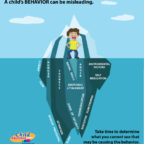Sensory Processing
Autism Awareness – Language Processing and Social Skills
Autism awareness requires an understanding of the importance of addressing language processing and social skills deficits.
As we enter Autism Awareness Month, we want to help parents understand the importance of a multi-disciplinary approach to working therapeutically with children on the spectrum.
Children on the spectrum are at risk for language and social challenges, often due to their individual processing challenges. Finding a team of professionals, (Occupational Therapist, Speech Therapist) who can identify the root of a child’s struggles is the first step to creating a plan on how to build a base for development in these areas.
 By taking into consideration the “whole child”, Occupational Therapists and Speech Therapists, working collaboratively under one roof, are able to help parents prioritize next steps to maximizing their child’s development and potential. The skilled clinicians will evaluate a child, determining his/her interests, personality, goals, motivation and strengths, as well as areas that can be improved. Using this information, they can plan an engaging program of intervention to target and remediate the child’s difficulties, and strengthen language processing and social skills concepts such as collaborative play, cooperation and negotiation.
By taking into consideration the “whole child”, Occupational Therapists and Speech Therapists, working collaboratively under one roof, are able to help parents prioritize next steps to maximizing their child’s development and potential. The skilled clinicians will evaluate a child, determining his/her interests, personality, goals, motivation and strengths, as well as areas that can be improved. Using this information, they can plan an engaging program of intervention to target and remediate the child’s difficulties, and strengthen language processing and social skills concepts such as collaborative play, cooperation and negotiation.
The compassionate therapists will work hard to form a solid, trusting and fun relationship with each child. They will pivot and evolve therapeutic strategies and implementations, to help a child generalize skills across the disciplines.
Social Pragmatic Language and Autism
Pragmatic language is the use of appropriate communication in social situations. Language deficits in children with autism will contribute to their difficulties with social interaction with peers, as they do not intuitively understand and use social communication concepts, and must be guided in the learning of these skills.
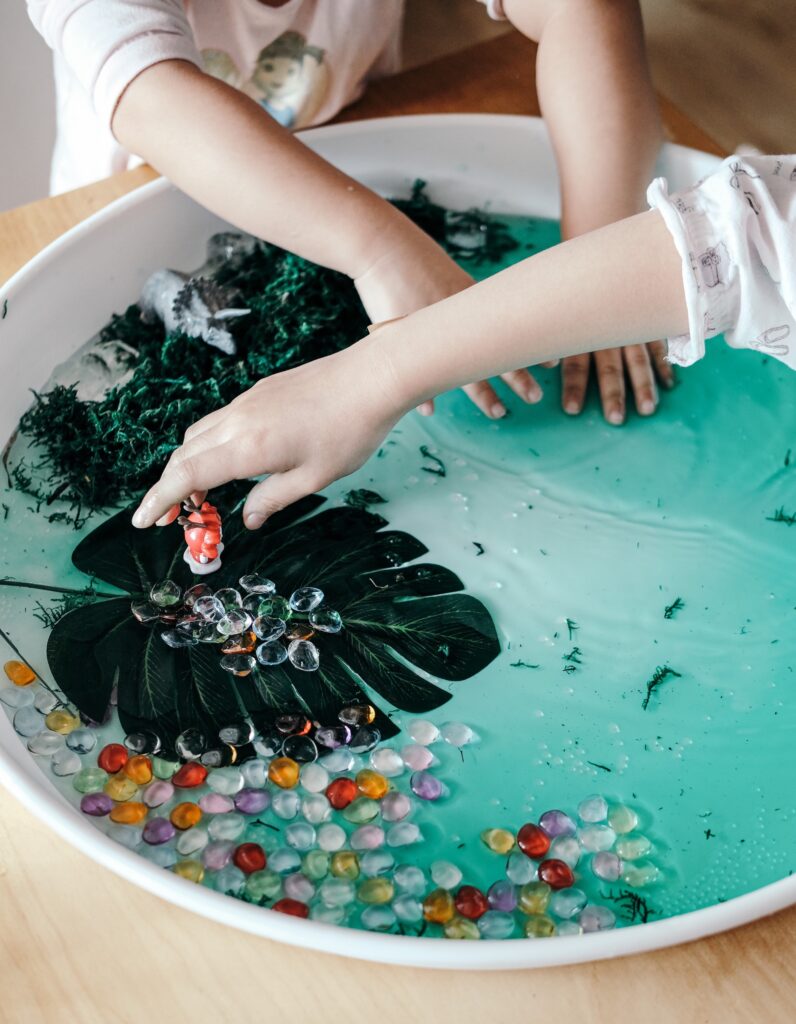 Because language is the vehicle that drives social interaction , difficulties with literal language comprehension and use will hinder success in turn taking, perspective taking, and reading social cues. Additionally, when a child cannot easily access language “on demand” during peer interactions, anxiety can form, and this can affect their self-confidence.
Because language is the vehicle that drives social interaction , difficulties with literal language comprehension and use will hinder success in turn taking, perspective taking, and reading social cues. Additionally, when a child cannot easily access language “on demand” during peer interactions, anxiety can form, and this can affect their self-confidence.
Bringing a child into a sensory gym allows the speech and occupational therapists to also observe and analyze a child’s behaviors as they engage in play, both solitary and peer-to-peer. The therapists use this environment to encourage use of language to facilitate successful play and engagement, resulting in a positive and confidence-building outcome for the child.
This interaction between language and social engagement, will also exercise and strengthen executive functioning, appropriate behavior, conversation and narrative language, reasoning, social problem solving (organization of thought), perspective taking, whole body listening, and humor.
During Autism Awareness Month, if your child is struggling on the spectrum, consider reaching out and learn more about learning opportunities facilitated by informed, knowledgeable and compassionate mentors, including teachers and therapists. Together, we can bridge the gap for your child and help him/her build the “scaffold” needed to move to higher learning and more successful social engagements.
Helping the Sensory Child Thrive
Is your child struggling to participate in family life?
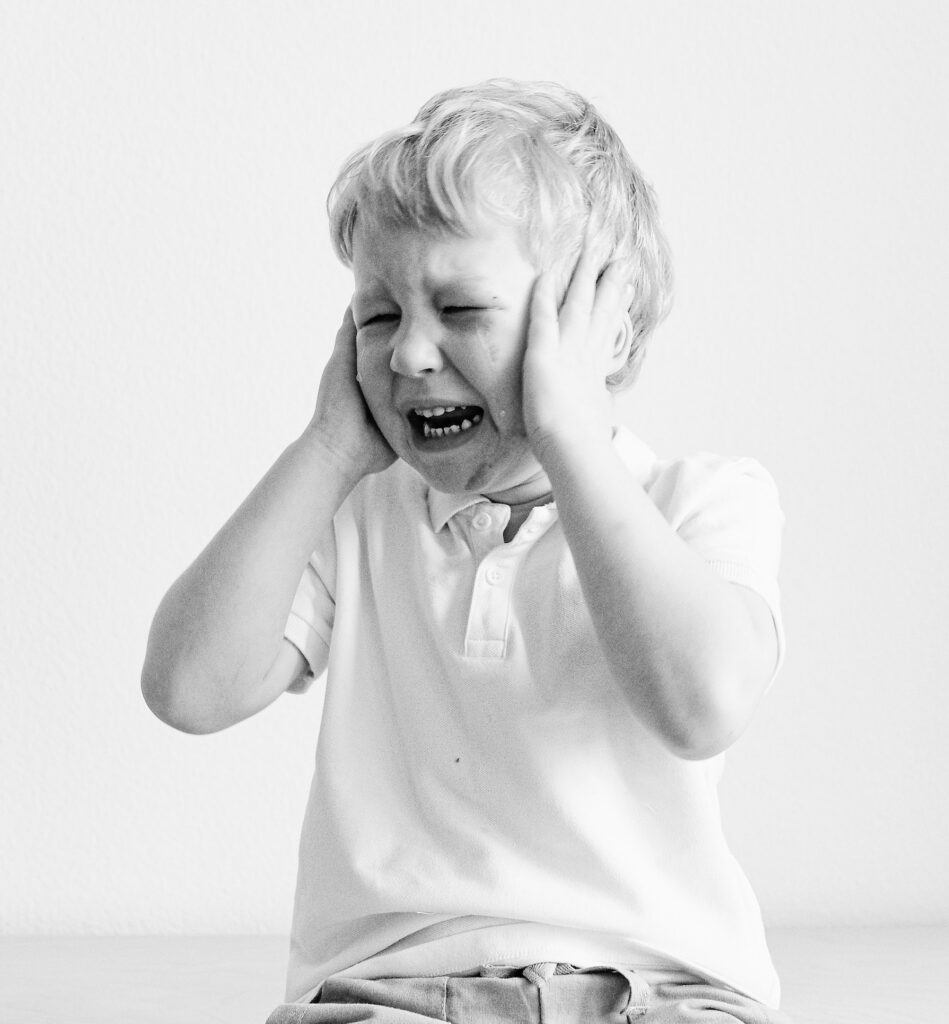
An “at the end of her rope” mom once said to me, “our son is holding our family hostage.” The stress and tension in the home were weighing heavy on mom, dad and older siblings.
While that sounds pretty dramatic, it is in fact a scene that plays out in families quite commonly, and perhaps even more now during the Covid-19 pandemic. This mom went on to tell me that her young son was loving, big hearted, and smart, as well as controlling, manipulative, prone to frequent temper tantrums and had a hard time keeping friends, and playing a role in family life as a team member and not dictator. With a deeper dive into the consultation, it was revealed that this young child was also hyper-sensitive to loud noises and rough clothing, and loved to cuddle and build things. What the mom sensed but didn’t really know, was that her son wasn’t a troubled child with behavior issues – but that something more was going on that made the world a harder place for him to thrive in. This child was a sensory child.
To be fair, we all are “sensory”, in as much as we all take in and process the sensory input we are constantly receiving. But, and this is big, when there is a “glitch” in the sensory processing systems , the results can be stressful on the brain, resulting in challenging behaviors – a child who is harder to parent and finds it hard to thrive in social environments.
Sensory processing skills develop differently for each child.
 Sometime between the ages of two and three, children begin to develop the ability to extend their attention span and follow an external plan – skills vital to social emotional growth. If, during this time, a child seems to be struggling in this area of development, there may be underlying factors impeding the process. We are all wonderful and unique in how our brain grows and develops. Different speeds and different strengths and challenges do occur along the journey. Sensory processing challenges can result in outbursts, tantrums, an unwillingness to socialize, go to school or play by the rules, and may be a precursor for learning or emotional challenges in the school aged child. We encourage parents that believe their child may be struggling in these areas, to get early support.
Sometime between the ages of two and three, children begin to develop the ability to extend their attention span and follow an external plan – skills vital to social emotional growth. If, during this time, a child seems to be struggling in this area of development, there may be underlying factors impeding the process. We are all wonderful and unique in how our brain grows and develops. Different speeds and different strengths and challenges do occur along the journey. Sensory processing challenges can result in outbursts, tantrums, an unwillingness to socialize, go to school or play by the rules, and may be a precursor for learning or emotional challenges in the school aged child. We encourage parents that believe their child may be struggling in these areas, to get early support.
Helping the sensory child thrive, not just survive.
When we know why a child is struggling we can modify, adapt and create an individual plan that sets up the child for emotional, social and learning success. An occupational therapist utilizing a sensory processing approach, can assess a child to identify the underlying sensory processing challenges. At that point, an individualized therapeutic strategy will be created that will address those challenges, and build the child’s self-regulation, joint attention, and promote imitation and shared reciprocal play.
It is critical to understand why a child’s nervous system is struggling to calm and regulate, listen and participate, and to empathize and relate successfully to others. The occupational therapist can help parents to identify and implement strategies that will build their child’s regulation, joint attention, attunement and engagement in the relationships and activities of the family, building a foundation for lifelong attention and learning.
Early therapeutic intervention can help prevent negative relationships, micro trauma, negative interactions, and stress and frustration within the family unit.
Seeking information to help you parent your individual child is a joyful and wonderful gift. Fear of the unknown often prevents parents from reaching out for more information. We all have a unique and individual sensory processing system. When each member of the family understands the unique sensory needs of the other, peaceful, successful interactions can occur with less challenge and stress.
If your child is struggling, and you are a struggling parent, please reach out to get help. We invite you to come and learn about your own sensory processing systems and those of your children so that your family can create goodness of fit for peace and joy in your family.
Helping a Child Learn About Non-Verbal Communication
Like all things topsy turvy in this strange new world we’re learning to live in, learning to learn, itself, has been turned upside down.
As occupational therapists working with children, we talk a lot about and address challenges common for children with sensory processing disorder – or the difficulty in dealing with sensory overload. Now, with parents, teachers, caregivers and peers all wearing masks, suddenly the problem is a lack of enough sensory input, in this case, visual input, making it difficult for young children developing early social skills, to understand feelings and expectations being communicated to them.
Our whole body is responsible for non-verbal communication, with verbal communication only accounting for 10%-30% overall. For young children or children with neuro-developmental differences, interacting with others in masks can be challenging – but our smile or frown, or anything in between, only accounts for a small amount of our non-verbal communications.
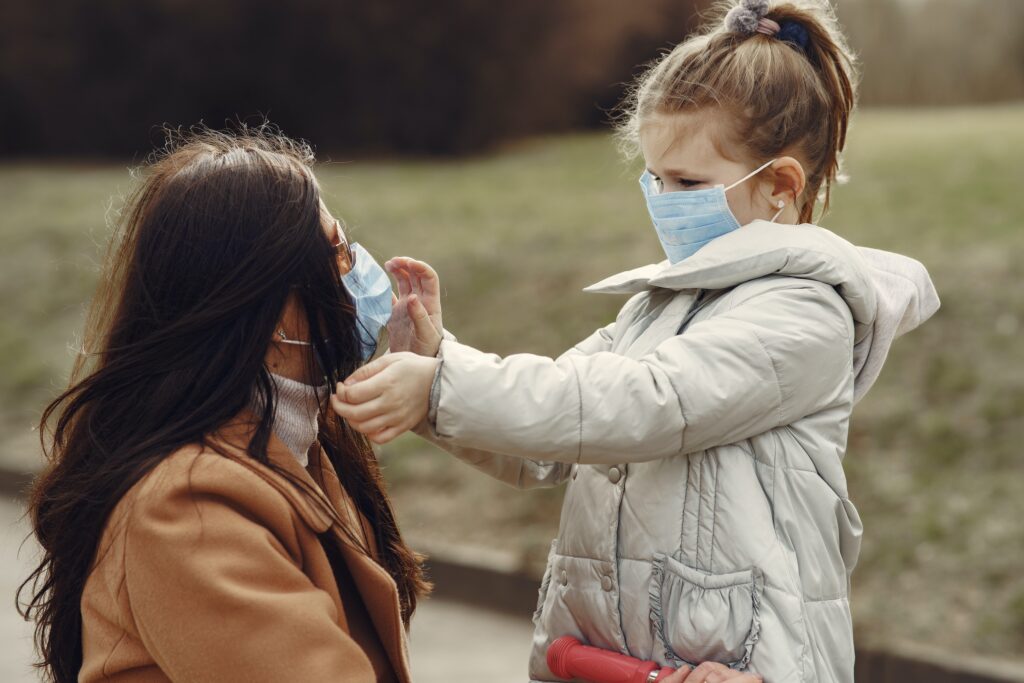 Now is a good time to encourage and guide your child to become a “social detective”, looking for whole body language (non-verbal) cues that hold the clues to ideas, thoughts, feelings, attitude and state of mind being communicated, much of which is produced subconsciously. While eyes opened wide or brows furrowed are pretty obvious indicators of feelings, many children have difficulty with the intimacy of sustained eye contact. The “social detective” will need to pay closer attention to a person’s posture, movements, and arm placement (crossed or open, for example), for bigger and easier indicators to use when determining friendship and attention.
Now is a good time to encourage and guide your child to become a “social detective”, looking for whole body language (non-verbal) cues that hold the clues to ideas, thoughts, feelings, attitude and state of mind being communicated, much of which is produced subconsciously. While eyes opened wide or brows furrowed are pretty obvious indicators of feelings, many children have difficulty with the intimacy of sustained eye contact. The “social detective” will need to pay closer attention to a person’s posture, movements, and arm placement (crossed or open, for example), for bigger and easier indicators to use when determining friendship and attention.
To support a child’s critical early social development during this time of masks and social distancing, parents might try role playing with their children, pointing out different body postures and positions, and discussing what information those positions might be relaying. Practicing guessing how family members are feeling at home with and without masks can help with feelings of anxiety when venturing out of the house. Using favorite TV shows or YouTube characters can be helpful as well! Pause the show, cover up the character’s face on the screen and see if the posture of the character matches the emotion they are feeling. A few non-verbal check-ins a day will help grow your child’s awareness and understanding of non-verbal communication, and how to connect to those communications and the people sending them.
Tips For a Successful Transition Back to School
Back to school tips to make the transition easier on the whole family.

With school about to resume after the long summer break, now is the time to put wheels in motion for a smooth transition to the back to school routine. These back to school tips will benefit the whole family.
Morning Routine
First and foremost on parents’ minds is likely some dread thinking about the “morning routine” of school time. Two weeks prior to the start of school, establish school appropriate bedtime and wake up times, and practice going to bed and waking up at those times. Determine what the school morning will look like for each member of the family. Don’t use words alone – try using visual schedules to illustrate routines. A checklist with added visuals helps children learn how to self assess if they have completed what is expected of them. Every child wants to succeed, and feeling successful with the morning routine is no different.
Who will prepare breakfast and lunch?
Make sure to leave enough time in the morning routine for eating breakfast or preparing healthy smoothies to go. Start planning breakfast and lunch options a couple of weeks before school starts too, especially if your child is a picky eater. Explore ways your child can learn to make their own healthy lunches with plenty of fruits, crunchy veggies and protein to fuel their brain throughout the day.
Transition of movement
As kids head back to school, it’s important for parents to understand that their child’s nervous system is going to go through a transition while their body gets used to having less active movement throughout their day. Summer time fun involves a lot of whole body big movement play. School time requires more small motor tabletop play and learning experiences. This shift in body movement can cause a child to get fidgety or anxious. Try not to increase this anxiety by emphasizing they should “sit still”, “be good”, or “pay attention”. Make sure they get a good amount of active movement during after school hours.
If your child has been seeing an occupational therapist working on strategies to support attention and regulation, or if there are certain words that help your child connect to whole body listening, share those strategies and words with your child’s teacher prior to the commencement of the school year.

Much of the tabletop play and learning will involve writing or drawing. The small motor skills required for both are not necessarily automatic and easy for all children. Watch how your child picks up and holds a marker or pencil, and if they experience joy or avoidance responses when doing so. If you notice a tendency towards avoidance, manipulation seems awkward or encumbered, or if their desire to do age appropriate drawing and writing does not develop, seek advice from a pediatric occupational therapist as early as possible.
Sensory Overload
The classroom environment may have a lot more sound and visual stimulus than a child might experience during a typical summer break day, as well as many more people in their immediate space. For some children, this additional sensory activity is joyful, but for those with sensory processing challenges, these circumstances can heighten the stress response. Be aware and observe your child as he transitions into these new situations, and appreciate how his/her brain may be working to modulate and process the incoming sensory information.
Children can also be overwhelmed by the amount of oral communication they have to process during a school day. They need to fire up their listening skills to follow direction, and their memory systems need to respond and perform in an expected manner in a group all day. Whew, that’s a lot! Don’t be surprised if they struggle with following directions and listening when they get home at the end of the day. Watch for chewing of shirt, pencils and other nonfood items – this is a sign that their nervous systems is needing help to regulate. Keep this in mind for the first couple of weeks and try not to overload them with too many additional directions.
Communication
![]() School requires children to be sharing thoughts and ideas, and following direction utilizing their language processing brains all day long. If they are struggling in any of these areas and if they were a late talker, seek a speech and language evaluation to gain insight into language processing, before social, emotional, or reading/spelling concerns develop as well.
School requires children to be sharing thoughts and ideas, and following direction utilizing their language processing brains all day long. If they are struggling in any of these areas and if they were a late talker, seek a speech and language evaluation to gain insight into language processing, before social, emotional, or reading/spelling concerns develop as well.
Speech intelligibility is a developmental process. Knowing when your child should be saying “s”, “l” and “r” sounds, to name a few, correctly can be confusing. This chart can be referenced as a guideline.
Finally, you and your child will feel tired as you transition sleep patterns and routines back to school. Be kind to both of your nervous systems and don’t over schedule your child’s after school activities. Some down time is a good thing – for both of you.
Understanding Interoception-New Insights into Common Childhood Issues
The little known sense, “interoception” might be the reason for common childhood issues with sleeping and potty training.
Interoception is the sense within the human body that enables it to experience, understand and react to the physiological state of itself. It has two main functions: body state and emotional state.
Interoception and Body States
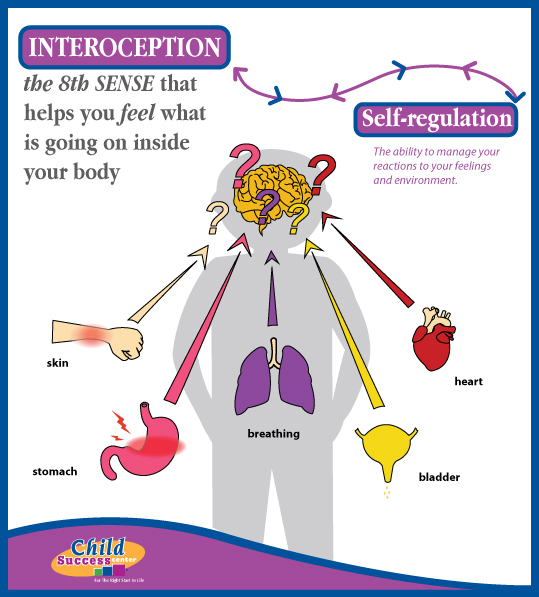 Body states involve the basic functions or physical conditions of the body and interoception allows us to feel and be aware of the inside of our bodies, including organs and skin. It is vital in helping us feel sensations such as pain, tickle, itch, body temperature, hunger, thirst, heart rate, breathing rate, muscle tension, pleasant touch, nausea, headache, sleepiness, and when we need to use the bathroom.
Body states involve the basic functions or physical conditions of the body and interoception allows us to feel and be aware of the inside of our bodies, including organs and skin. It is vital in helping us feel sensations such as pain, tickle, itch, body temperature, hunger, thirst, heart rate, breathing rate, muscle tension, pleasant touch, nausea, headache, sleepiness, and when we need to use the bathroom.
The ultimate goal is for our bodies to reach homeostasis, an internal balance of systems using the least amount of energy. When our internal balance, or homeostasis, is off, our interoceptive system signals our body to take action. For example, if we experience a dry throat and mouth, our interoceptive system, if working properly, will tell our brain that we are thirsty and we need to get a drink of water, which results in decreased discomfort and reduced dry throat and mouth. However, if our interoceptive system is not working properly, signals can be misinterpreted by our bodies, resulting in what presents as an “outburst,” “tantrum,” or “shutdown”, agreeably inappropriate reactions to thirst.
Likewise, if our interoceptive system sends a signal indicating a full bladder and the message is not processed correctly, the appropriate response of heading to a bathroom might not occur. A chronic inability to react appropriately to a given signal can lead to emotional distress and compensatory behavior such as moodiness, nervousness or distraction.
Interoception and Emotional States
Emotional states involve our moods and the emotional conditions of our bodies. The interoceptive system helps us to regulate our emotions, identify our emotions, and determine how we view other’s emotions. It helps us identify anger, embarrassment, happiness, anxiety, excitement, sadness, and fear. For example, a fast heartbeat, tingly stomach, and shaking muscles could mean you are anxious, while slow/rhythmic breathing and loose muscles could mean you are relaxed.
Our ability to self-regulate is closely tied to our interoceptive system. If our interoceptive system is working properly, we are aware of our internal signals (thirst, hunger, full bladder, heart rate, etc.) and able to guide our reaction to those signals. A person with poor emotional awareness could have an interoceptive system that is working inefficiently and therefore not providing clear body signals. Without clear body signals, they may not notice subtle differences in the way each emotion feels and can result in difficulty identifying and controlling those emotions.
Without clear and understood awareness of their internal state, it can be impossible to develop good self-regulation skills, therefore impacting a child’s ability to successfully engage within their social and physical environment. Helping your child begins with learning about treatment options. Occupational therapy, with a focus on sensory processing and with the use of mindfulness activities, can help facilitate interoceptive processing and awareness.
Child Success Center offers many options in the way of treating sensory processing issues and building your child’s interoceptive system. Call today to learn more about our individualized, peer-to-peer and group programs.
Learn more about Child Success Programs that support development of a child’s interoceptive system…
Choosing a Halloween Costume for the Sensory Child
 The wrong Halloween costume can create a scary Halloween for the sensory child.
The wrong Halloween costume can create a scary Halloween for the sensory child.
For the sensory child, everyday encounters involving touch can become a monumental issue. An over or under sensitivity to touch and texture can make eating, showering and getting dressed a real challenge.
This challenge can make the annual choosing of a Halloween costume a frightening event. The sensory child may find the myriad textures of super hero and monster costumes just too intolerable and uncomfortable due to tactile sensitivities. One child may prefer a loose fitting costume – another, something that fits snugger. Sometimes seams or tags are the culprits. Evaluate what your child is comfortable with for his everyday attire then seek costumes that fit those criteria.
Something else to consider is the time and place where your child tries on his costume. Children with tactile sensitivities are often in a state of hypersensitive alertness and high arousal. Try on Halloween costumes at a time when the child is calm and without agenda.
Perhaps wearing familiar, comfortable clothing under their costume might be the easiest fix when the “perfect” costume isn’t perfectly comfortable. Washing the costume before wearing and a trial run may also be beneficial to ensuring a successful and happy “trick-or-treating” experience.
And in case all those precautions fail at the last minute and your child’s first choice costume just isn’t working out, prepare to have a “backup” costume made from your child’s tried and true favorite clothing. Being prepared helps keep the situation light and everyone smiling.
Happy Halloween!
What is a Sensory Diet?
Sensory Diet – Ways an OT (Occupational Therapist) works with Children and Families to Support Regulation
What really is a sensory diet?
Many occupational therapists use the term, “sensory diet”, when working with children with developmental and/or learning challenges. The term sensory diet was coined by Patricia Wilbarger, M.Ed., FAOTA, OTR in 1984 to indicate the use of a combination of sensory strategies to keep a person at the optimal level of arousal. All human beings unconsciously use sensory diets every day. We exercise, drink coffee, listen to music, retreat to a quiet space when the world gets overwhelming, chew/crunch and eat foods that often make us happy.
Self-regulation is something everyone continually works on, whether we are cognizant of it or not.
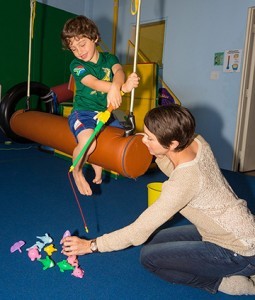
Children who are struggling with self-regulation and utilizing the “just right” behaviors that are expected in different environments do not have the mindfulness, resources or control to seek out the activities that may help them shift from the Red Zone (mad, angry) or the Yellow Zone (silly, out of control, anxious) to the Green Zone (ready to listen and learn). Learn more about the Zones of Regulation.
“Sensory modulation” is a therapeutic term used to describe one’s ability to respond appropriately to sensory input and to stay focused on the activity at hand. It may be used with regard to children and adults who may be under- responsive, sensory seeking and or over responsive. It is never black and white. Working with an occupational therapist will help parents and teachers get a better understanding of the why, what and how of “sensory modulation”. The OT will help parents understand the behaviors of a child, help to identify and remove triggers from their environment and better equip the child’s nervous system to cope with the highly sensory world we live in.
An occupational therapist that has spent time assessing a child’s responses to various sensory information, known as “sensory processing/integration” , will design a sensory diet tailored to that child’s needs. This “diet” will include the tools required, (deep pressure, hugging, taking a break, belly breathing, drinking water, wall pushes) and a schedule outlining when to use them, that will support a child’s overall regulatory state and therefore ability to engage in relationships and his/her environment in a successful way.
Additional Resources for Sensory Processing Disorder and Sensory Integration
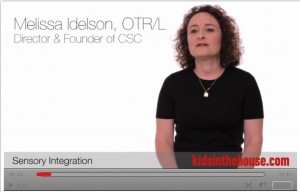 Sensory Processing/Sensory Integration
Sensory Processing/Sensory Integration
What is Sensory Integration – Video
Sensory Processing Disorder Foundation
Handling the Hustle and Bustle of the Holidays
Mom and Dad set the tone at home during the holidays.
We often think about how our children will experience the holiday season, but what about Mom and Dad? The holidays can be the most joyful, yet stressful time of the year. And, sometimes it isn’t the kids we really need to worry about, but ourselves! How parents handle the holiday season will have a direct impact on what their kids take away. And since the holidays can be an especially magical time for little ones, it’s important that parents remember to take a deep breath and enjoy the ride.
Here are a few tips to ensure a more relaxing holiday season:
- Try not to take it all so seriously. The holidays will happen whether we’re “ready or not.” Sit back and remember to enjoy the season. Also don’t forget that the traditions your family celebrates are all routed in another meaning – and they usually don’t involve parties and gifts! Try to remember why we honor the holidays in the first place.
- Give yourself – and your family – a break by not over scheduling social commitments, gatherings and festivities. When you try to do too much, you risk missing it all.
- Build in couples-only time for you and your spouse to “take five” and sneak away for a reprieve from the holiday madness. Arrange for a babysitter, family member or friend to watch your children and enjoy a solo dinner or even a stroll through your neighborhood to catch the holiday lights.
- Remember that for your little ones, the holidays are already filled with awe and joy because they’re different from the routine. Many parents try to too hard to make it all special when it already is. The only thing for parents of children who have Sensory Processing Disorder (SPD) issues to keep in mind is to shelter their little ones from noisy parties; the over-stimulation of lights, music and commotion; and unfamiliar family members that hug, kiss and touch kids who may be uncomfortable with that kind of attention. By being aware of the “sensory world,” parents can help their children to be more at ease, and, in turn, can ensure a more relaxed holiday experience for the whole family.
- Try to grab a little extra sleep, take a warm bath, indulge in one extra treat at the buffet table, and – if you can afford the time and cost – let yourself be pampered, even if it’s only for one hour. Even parents deserve a little something extra from Santa because the joy of the season should always come for grown-ups too!
Is Your Child’s Handwriting Ability Slowing Their Academic Progress?
Sensory Perception and Handwriting Skills
Each school year academic challenges increase. It is crucial for a child to have strong handwriting skills to help them master these new challenges, without the task becoming overwhelming. Handwriting efficiency is influenced by a variety of factors, including a child’s sensory perception.
Continue reading
How Visual Perception Can Affect a Child’s Learning
School requires a great deal from every sensory system and if even one system is delayed, a student could  struggle with learning to read, write, socialize and attend to his/her teacher’s lessons.
struggle with learning to read, write, socialize and attend to his/her teacher’s lessons.
The visual system is possibly the most powerful, yet most overlooked, sensory system in the body. Even if a child has “perfect” visual acuity (20/20) they may still have other visual deficits that can hinder their school success. There are many types of visual perception that interpret what we see.

